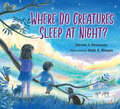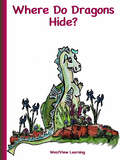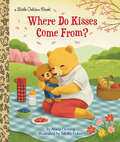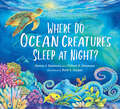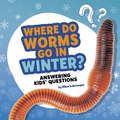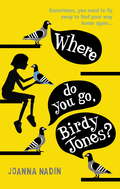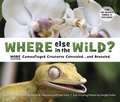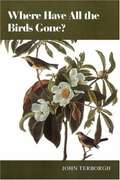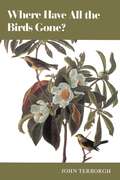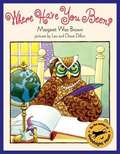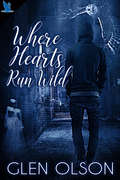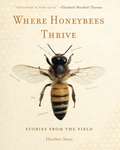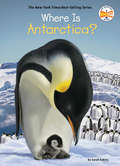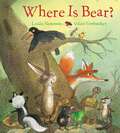- Table View
- List View
Where Do Creatures Sleep at Night?
by Steven J. SimmonsAnimals sleep, just like you! But where? And how? Let's take a look at what creatures do / when you are asleep and the day is through . . .We're used to seeing animals during the day, but where and how do they sleep at night? From butterflies to bees and frogs to fish, from birds to horses and squirrels to bunnies, plus cats and dogs, this sweet book in rhyme shows kids where animals bed down while kids are also asleep. Following a brother and sister on a farm where all the animals can be found, this book teaches and delights!
Where Do Dragons Hide?
by Rkh Bowman Joan Casler Heather StannardFollow Robert's adventure as he searches for the elusive Dragons that he has heard about each night when his father reads to him before bed. Children ages 4+ will enjoy this delightful tale of imagination.
Where Do Kisses Come From? (Little Golden Book)
by Maria FlemingShow your little ones what makes them so kissable with this adorable Little Golden Book. There are so many kinds of kisses, little one. I-missed-you kisses . . . thank-you kisses . . . feel-better kisses . . . and kisses just because. This delightful picture book is an ode to the strongest of bonds--the love from a parent. Where Do Kisses Come From? is illustrated with family scenes of cuter-than-cute animals expressing their love for their little ones. Makes a terrific read-aloud treat on Valentine's Day or any day!
Where Do Ocean Creatures Sleep at Night?
by Steven J. Simmons Clifford R. SimmonsOcean animals sleep, just like you! This informative, rhyming picture book dives deep to look at where and how ocean animals sleep in the sea.Many ocean animals are active during the day, but where and how do they sleep at night? From sharks to dolphins and sea turtles to octopuses, plus parrotfish and whales and more, discover what these ocean creatures do when it&’s time to go to sleep and the day is through.Where Do Ocean Creatures Sleep at Night? is newest addition to a three-book series, which includes Where Do Creatures Sleep at Night? and Where Do Big Creatures Sleep at Night? "Where Do Ocean Creatures Sleep at Night showcases wondrous watercolor illustrations that capture the allure of the sea. The rhyming rhythm dances through captivating animal facts about water-dwelling creatures before concluding in a cozy child's bedroom. Crafted to be a favorite bedtime read, this book is a must-have for the bookshelves of ocean lovers.&”– Bethany Stahl, Bestselling Author of Save the Ocean&“All mammals and most other animals need sleep, including those living in marine environments. This picture book&’s palette of soft colors and informative rhyme will introduce children to various facts about specific ocean animals and how they rest. Perfect for a bedtime read-aloud, this book will help young listeners and readers cuddle up together in their nice dry bed and sleep as tight as otters.&”– Sara T. Behrman, former librarian and author, The Sea Hides A Seahorse&“A delightful bedtime book! This jaunt into the ocean to learn about how our marine friends sleep will easily become part of your family bedtime routine. The charming illustrations are sure to captivate the imagination of children and inspire a love for the wonders of the sea, while sending them on a happy trip to dreamland.&” – Anne Richardson, Author of Octopuses Have Zero Bones and Chief Experience Officer at The Exploratorium "Scientific, sweet, and salty!"- Karen Romano Young, Deep Sea Diver and Award-winning Author of Whale Quest "This book is an absolute delight- the Dr. Seuss Sleep Book reimagined for the ocean. A beautiful way to unwind while learning a little more about our mysterious watery world. Where Do Ocean Creatures Sleep at Night? will surely inspire a future marine biologist or two!"- Paige Hoel, Ph.D. candidate, Oceanography, UCLA Atmospheric and Oceanic Sciences"A gorgeously illustrated children&’s book that will inspire the next generation of marine biologists, conservationists, and animal lovers. The accurate animal facts were a breath of fresh air to find in this genre and will make learning fun for children and adults alike!&”- Kristyn Plancarte, Marine Biologist and animal trainer&“Dive into an underwater world of wonder and imagination. This delightful read features stunning artwork that brings the ocean to life for bedtime. From playful dolphins to sleepy sea turtles, families will climb aboard an informative journey through the sea." - Kendra Nelson, Marine Conservationist
Where Do Polar Bears Live?
by Sarah L. ThomsonLet's-Read-and-Find-Out about Polar Bears. The Arctic might be a bit too chilly for you or me to live there, but it is the perfect home for polar bears. The fur between the pads of their paws keeps them from slipping on the ice. Their skin and blubber are like a warm blanket. But the earth is getting warmer and the ice is melting. Where will the polar bears live? How can we help protect their home? Read and find out! <P><P>[This text is listed as an example that meets Common Core Standards in English language arts in grades 2-3 at http://www.corestandards.org.]
Where Do Worms Go in Winter?: Answering Kids' Questions (Questions and Answers About Animals)
by Ellen LabrecqueBirds have wings to fly somewhere warm in winter. But worms don’t have wings or even any legs. Where do they go? You will learn all about worms and how they survive when the weather turns cold.
Where Do You Go, Birdy Jones?
by Joanna NadinFrom the author of JOE ALL ALONE - a BAFTA winning and Emmy nominated CBBC series.A story about finding yourself when everything changes and believing that love never runs out. Perfect for fans of A Boy called Hope and Jacqueline Wilson.Eleven-year-old Birdy Jones is all alone. She doesn't belong at school, at home, or even with her dad anymore. The only place she feels like herself is at her grandpa's pigeon loft, where the familiar warmth and birdsong block out the world. It's also where she meets Dogger - her only friend and the one person who really seems to know where she's coming from.Birdy used to be happy, when it was just her and Dad, but now she has a stepmum, a little sister, and another baby on the way. Worse, her growing family needs to move house, but Birdy doesn't believe there'll ever be enough room for her in Dad's busy life - and she can't leave Grandpa and the pigeons. She won't.Birdy dreams of a different family and future, and with Dogger's help she decides to find one - even if it means running away from everything she's ever known. But sometimes you need to fly away to find your way home again . . .
Where Does My Dog Hurt
by Renee TuckerA do-it-yourself method of determining when and where your dog hurts.Keep your dog pain-free and feeling and performing his best! Introducing 23 simple body checkups you can do at home on your dog. This remarkably easy-to-follow book helps you:Clear up behavior problems or training issues you may have struggled with for months.Become familiar with your dog's normal range of movement so you can prevent minor issues from becoming major.Tune in to areas of temporary or chronic discomfort so you can offer relief as needed.Solve &“mystery&” limps, gimps, and lamenesses.Save thousands of dollars by avoiding expensive diagnostics that leave you with more questions.Captain your dog's team of veterinarian, trainer, chiropractor, and other therapists with confidence.Keep your dog active and happy for more months of the year, and more years of his life.Clear, colorful anatomical illustrations and how-to photographs demonstrate each body checkup, from nose to tail. Sensible organization allows you to move purposefully and progressively when trying to pinpoint a problem, while also ensuring that it is easy to find what you need, when you need it. With considerations for all canines, of every size and breed, and the goal of optimal health and a vibrant quality of life, this practical book is for everyone who counts a dog as a friend or family member.
Where Does My Horse Hurt?
by Renee TuckerKeep your horse pain-free and performing his best!Introducing 27 simple body checkups you can do on your horse,Where Does My Horse Hurt? is a do-it-yourself method for determining when and where your horse hurts. With this easy-to-follow book, conveniently spiral-bound so you can lay it open on your tack trunk and follow the instructions as you work on your horse you will:Become familiar with your horse's normal range of movement so you can prevent minor issues from becoming major.Stay in tune with areas of temporary or chronic discomfort so you can offer relief as needed.Solve mystery or phantom lamenesses that come and go seemingly without reason.Save thousands of dollars by avoiding expensive diagnostics that rarely get you answers.Learn how to discuss potential problem areas with farriers, veterinarians, and bodyworkers.Keep your horse actively and happily in work for more months of the year, and more years of his life.
Where Else In The Wild?
by David M. Schwartz Yael Schy Dwight KuhnDid you find that sneaky orchid mantis hiding on the cover? This book is full of similarly sly species-and they're all hiding in plain sight. Think you've spotted one?<P><P> Lift the flap to find out Each of the camouflaged creatures on these pages, from chickadees to crayfish, is disguised for a reason.Some are on the prowl for prey, while others hide from hungry predators. Discover why geckos have a spooky reputation; why it pays for a mouse to have a dark-colored back and light-colored belly; and why you wouldn't want to be fooled by a scorpion fish.<P> In this follow-up to the acclaimed Where in the Wild?, David Schwartz, Yael Schy, and Dwight Kuhn take readers on another remarkable tour through the fascinating world of animal camouflage.
Where Has Home Gone
by Janelle PollardWhen Puggles woke up, none of his toys were to be seen. He knew it was not going to be a normal day. Home had vanished! What Puggles did not know was the adventures to come in finding his home: a motorbike ride, a boat trip and more. Come help Puggles find his home!
Where Have All The Birds Gone?: Essays On The Biology And Conservation Of Birds That Migrate To The American Tropics
by John Terborgh"Things are going wrong with our environment," writes John Terborgh, "even the parts of it that are nominally protected. If we wait until all the answers are in, we may find ourselves in a much worse predicament than if we had taken notice of the problem earlier. By waiting, one risks being too late; on the other hand, there can be no such thing as being too early." Terborgh's warnings are essential reading for all who care about migratory birds and our natural environment. Why are tropical migrant species disappearing from our forests? Can we save the birds that are left? Terborgh takes a more comprehensive view of migratory birds than is usual--by asking how they spend their lives during the half-year they reside in the tropics. By scrutinizing ill-planned urban and suburban development in the United States and the tropical deforestation of Central and South America, he summarizes our knowledge of the subtle combination of circumstances that is devastating our bird populations. This work is pervaded by Terborgh's love for the thrushes, warblers, vireos, cuckoos, flycatchers, and tanagers that inhabited his family's woodland acreage while he was growing upbirds that no longer live there, in spite of the preservation of those same woods as part of a county park. The book is a tour of topics as varied as ecological monitoring, the plight of the Chesapeake wetlands, the survival struggle of Central American subsistence farmers, and the management of commercial forests.
Where Have All the Bees Gone?: Pollinators in Crisis
by Rebecca E. HirschApples, blueberries, peppers, cucumbers, coffee, and vanilla. Do you like to eat and drink? Then you might want to thank a bee. Bees pollinate 75 percent of the fruits, vegetables, and nuts grown in the United States. Around the world, bees pollinate $24 billion worth of crops each year. Without bees, humans would face a drastically reduced diet. We need bees to grow the foods that keep us healthy. But numbers of bees are falling, and that has scientists alarmed. What's causing the decline? Diseases, pesticides, climate change, and loss of habitat are all threatening bee populations. Some bee species teeter on the brink of extinction. Learn about the many bee species on Earth—their nests, their colonies, their life cycles, and their vital connection to flowering plants. Most importantly, find out how you can help these important pollinators. "If we had to try and do what bees do on a daily basis, if we had to come out here and hand pollinate all of our native plants and our agricultural plants, there is physically no way we could do it. . . . Our best bet is to conserve our native bees." —ecologist Rebecca Irwin, North Carolina State University
Where Have All the Birds Gone?: Essays on the Biology and Conservation of Birds That Migrate to the American Tropics
by John Terborgh"Things are going wrong with our environment," writes John Terborgh, "even the parts of it that are nominally protected. If we wait until all the answers are in, we may find ourselves in a much worse predicament than if we had taken notice of the problem earlier. By waiting, one risks being too late; on the other hand, there can be no such thing as being too early." Terborgh's warnings are essential reading for all who care about migratory birds and our natural environment. Why are tropical migrant species disappearing from our forests? Can we save the birds that are left? Terborgh takes a more comprehensive view of migratory birds than is usual--by asking how they spend their lives during the half-year they reside in the tropics. By scrutinizing ill-planned urban and suburban development in the United States and the tropical deforestation of Central and South America, he summarizes our knowledge of the subtle combination of circumstances that is devastating our bird populations. This work is pervaded by Terborgh's love for the thrushes, warblers, vireos, cuckoos, flycatchers, and tanagers that inhabited his family's woodland acreage while he was growing upbirds that no longer live there, in spite of the preservation of those same woods as part of a county park. The book is a tour of topics as varied as ecological monitoring, the plight of the Chesapeake wetlands, the survival struggle of Central American subsistence farmers, and the management of commercial forests.
Where Have All the Birds Gone?: Nature in Crisis
by Rebecca E. HirschBirds are disappearing. Birds are nature's essential workers, and they are crucial members of ecosystems around the world. Hummingbirds pollinate our flowers; cardinals munch on beetles, grasshoppers, and other pests that damage crops; owls eat rodents that can spread disease; vultures clean up roadkill and other waste. Beyond their practical aspects, birds bring us joy through their songs and beautiful feathers. But since 1970, nearly 30 percent of all birds in the United States and Canada have vanished. Scientists are scrambling to figure out what may be causing such a drastic decline. The answer: humans. City lights and tall glass skyscrapers disorient migrating birds. Domesticated cats prowling outdoors kill billions of birds each year. Pesticides contaminate fish and insects, which are then consumed by birds of prey. And climate change might disrupt and even wipe out feeding grounds for entire species. Discover the vast impacts birds have on ecosystems, food systems, and human communities, and learn more about what scientists are doing to protect them. “Never have my astonishment, wonder, and admiration been so stirred as when I have witnessed these birds drop from their course like meteors from heaven.” —Simon Pokagon, Potawatomi tribal leader “In pushing other species to extinction, humanity is busy sawing off the limb on which it is perched.” — American biologist Paul R. Ehrlich “There’s something everyone can do in their lives and in their communities to make it a better place for birds and people.” — Gary Langham, chief scientist, National Audubon Society
Where Have All the Pandas Gone?
by Melvin Berger Gilda BergerWhere have all the pandas gone? From the bamboo forests of China--to near extinction. Today, there are only about 1,000 giant pandas left in the entire world. In the well-received conversational style that sets this series apart, this book explores three basic questions about endangered species: Where have these animals gone? Why are they disappearing? Are people saving them? The Bergers explain the disappearance of not only giant pandas, but also of mountain gorillas, monkeys, tigers, rhinoceroses, and bald eagles, to name a few.
Where Have You Been?
by Margaret Wise BrownAges 3-6 Where has the Little Old Cat been? To see this and that Said the Little Old Cat Where does the Little Old Fish swim? Wherever I wish Said the Little Old Fish . . . Have you ever wondered where a cat or a squirrel has been or where a bird flies or a whale sails? How about why a bunny runs? With playful, rhyming verse, WHERE HAVE YOU BEEN? Perfectly captures the wonderful, wise questions that children ask every day.
Where Hearts Run Wild
by Glen OlsonA cunning and wild horse gallops the Colorado open plains with the spirit of a storm. The wayward youth and the horse meet and recognize their likeness to one another. Magically an attraction is formed and the two venture into a world where reality rubs against their nature which can either result in success or failure – no middle ground, no compromises. The youth experiences a series of painful trials that twist and turn his life. The end result is a transformation into the light as he experiences a spiritual awakening in his darkest hours.
Where Honeybees Thrive: Stories from the Field (Animalibus)
by Heather SwanColony Collapse Disorder, ubiquitous pesticide use, industrial agriculture, habitat reduction—these are just a few of the issues causing unprecedented trauma in honeybee populations worldwide. In this artfully illustrated book, Heather Swan embarks on a narrative voyage to discover solutions to—and understand the sources of—the plight of honeybees.Through a lyrical combination of creative nonfiction and visual imagery, Where Honeybees Thrive tells the stories of the beekeepers, farmers, artists, entomologists, ecologists, and other advocates working to stem the damage and reverse course for this critical pollinator. Using her own quest for understanding as a starting point, Swan highlights the innovative projects and strategies these groups employ. Her mosaic approach to engaging with the environment not only reveals the incredibly complex political ecology in which bees live—which includes human and nonhuman actors alike—but also suggests ways of comprehending and tackling a host of other conflicts between postindustrial society and the natural world. Each chapter closes with an illustrative full-color gallery of bee-related artwork.A luminous journey from the worlds of honey producers, urban farmers, and mead makers of the United States to those of beekeepers of Sichuan, China, and researchers in southern Africa, Where Honeybees Thrive traces the global web of efforts to secure a sustainable future for honeybees—and ourselves.
Where Honeybees Thrive: Stories from the Field (Animalibus: Of Animals and Cultures #10)
by Heather SwanColony Collapse Disorder, ubiquitous pesticide use, industrial agriculture, habitat reduction—these are just a few of the issues causing unprecedented trauma in honeybee populations worldwide. In this artfully illustrated book, Heather Swan embarks on a narrative voyage to discover solutions to—and understand the sources of—the plight of honeybees.Through a lyrical combination of creative nonfiction and visual imagery, Where Honeybees Thrive tells the stories of the beekeepers, farmers, artists, entomologists, ecologists, and other advocates working to stem the damage and reverse course for this critical pollinator. Using her own quest for understanding as a starting point, Swan highlights the innovative projects and strategies these groups employ. Her mosaic approach to engaging with the environment not only reveals the incredibly complex political ecology in which bees live—which includes human and nonhuman actors alike—but also suggests ways of comprehending and tackling a host of other conflicts between postindustrial society and the natural world. Each chapter closes with an illustrative full-color gallery of bee-related artwork.A luminous journey from the worlds of honey producers, urban farmers, and mead makers of the United States to those of beekeepers of Sichuan, China, and researchers in southern Africa, Where Honeybees Thrive traces the global web of efforts to secure a sustainable future for honeybees—and ourselves.
Where Is Alfred?
by Mircea VasiliuJoin the adventure of Alfred and see what happens to an alligator who misses his home.
Where Is Antarctica? (Where Is?)
by Jerry Hoare Sarah Fabiny Who HqExplore Antarctica--the coldest, driest, and windiest continent on Earth--in this adventure-filled title in the Who HQ series.Antarctica, the earth's southernmost continent, was virtually untouched by humans until the nineteenth century. Many famous explorers journeyed (and often died) there in the hope of discovering a land that always seemed out of reach. This book introduces readers to this desert--yes, desert!--continent that holds about 90 percent of the world's ice; showcases some of the 200 species that call Antarctica home, including the emperor penguin; and discusses environmental dangers to the continent, underscoring how what happens to Antarctica affects the entire world.
Where Is Bear?
by Lesléa NewmanThe animals in the forest are playing hide-and-seek, and everyone is found--except for the biggest one of all! Where, oh where, could Bear have gone? One thing is certain: Bear's friends will do whatever it takes to find him. Lesléa Newman's rhythmic text and Valeri Gorbachev's charming illustrations will make every child eager to join this playful search for the missing Bear.
Where Is Magenta? (Blue's Clues Discovery Series, Book #3)
by Ronald KiddBlue gets a postcard from Magenta, who has gone on a vacation. But where has Magenta gone? Play Blues Clues to find out!
